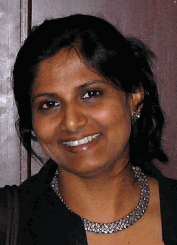Professor Priya Natarajan
The Newscientist article How big can a black hole grow? said
“Just how big can a black hole grow? Two astronomers reckon they have worked out the answer: colossal black holes with a mass of up to 50 billion suns could be lurking out there — but that’s the limit.Even bigger black holes are waiting to be found, say Priya Natarajan of the Harvard-Smithsonian Center for Astrophysics in Cambridge, Massachusetts, and Ezequiel Treister of the European Southern Observatory in Santiago, Chile.
In a study to appear in Monthly Notices of the Royal Astronomical Society, the pair examined the ‘feeding habits’ and growth of black holes. They used data from surveys carried out by other teams that observed the X-rays and visible light emitted by matter as it is devoured by black holes. The properties of this radiation can be used to estimate a black hole’s mass and how quickly it is gobbling up its surroundings.”
Priya Natarajan, Ph.D. is Associate Professor in the Departments of Astronomy and Physics at Yale University. She is a theoretical astrophysicist interested in cosmology, gravitational lensing, and black hole physics. She is on leave from Yale for the academic year 2008–09 and is the Emeline Bigelow Conland Fellow and Bunting Fellow at the Radcliffe Institute for Advanced Study at Harvard.
She was a Whitney Humanities fellow at Yale (2006 – 2007), and a fellow of Saybrook College. She is an Associate of the Dark Cosmology Centre, Niels Bohr Institute, at the University of Copenhagen, Denmark. She was a member of the Extra-galactic Time Allocation Committee for the Cycle 9 Program of the Hubble Space Telescope. She is a Member of the Advisory Board of scienceNOW at NOVA, WGBH Boston. She writes a fortnightly column on astronomy for the SciencePlus section of the Indian newspaper, Asian Age.
Priya edited The Shapes of Galaxies and their Dark Halos, authored Modeling the Accretion History of Supermassive Black Holes, and coauthored The survival of dark matter halos in the cluster Cl0024+16, Consequences of dark matter self-annihilation for galaxy formation, The evolution of massive black hole seeds, How robust are the constraints on cosmology and galaxy evolution from the lens-redshift test?, Strong lensing statistics in large, z~<0.2 surveys: bias in the lens galaxy population, The Observed Concentration-Mass Relation for Galaxy Clusters, and Substructure in lensing clusters and simulations. Read the full list of her publications!
She has undergraduate degrees in Physics and Mathematics from M.I.T. She is also interested in the history and philosophy of science. She was enrolled in the MIT Program in Science, Technology & Society from 1991 to 1993. She did her graduate work at the Institute of Astronomy, University of Cambridge in England, where she was a member of Trinity College and elected to a Title A Research Fellowship that she held from 1997 to 2003. She earned her Ph.D. in Astrophysics from the Institute of Astronomy, University of Cambridge. Prior to coming to Yale, she was a visiting postdoctoral fellow for a few months at the Canadian Institute for Theoretical Astrophysics in Toronto, Canada.
Read her Wikipedia profile.
